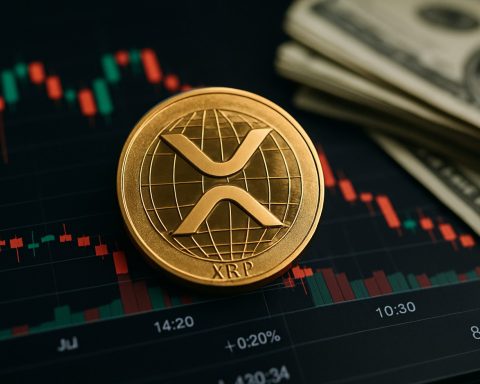- Ethereum’s gas fees have significantly dropped to around $0.01 per transaction, but this is not entirely positive news.
- The low fees result from a lack of growth in transaction volume rather than technological advancements, suggesting stagnant network usage.
- This stagnation challenges Ethereum’s position as a cornerstone for DeFi, NFTs, AI, and DePIN due to unchanged transaction volumes.
- Ethereum’s narrative of increased usage driving token value is contradicted by reality, with its value down 38% over three years.
- While competitors like Solana are capitalizing on cost efficiency and speed, Ethereum faces scaling challenges that need resolution for future optimism.
- The current scenario signals a missed opportunity for Ethereum, urging investors to reconsider their positions amidst potential market turbulence.
Ethereum has long been synonymous with innovation and untapped potential in the sprawling universe of cryptocurrency. Yet, its notorious gas fees—a toll collected with every transaction—have been a thorn in its side, causing investors and users alike to grimace. Recently, Ethereum’s gas fees appeared to plummet to a level unseen in years—around $0.01 per transaction. This should be a clear-cut victory for Ethereum, signaling reduced costs and improved usability, but there’s more beneath the surface.
The quick drop in gas fees isn’t entirely positive news. While low transaction costs may sound appealing, they have not resulted from groundbreaking technology launched recently. Instead, they’re the byproduct of an unsettling equilibrium. Despite numerous attempts to bolster Ethereum’s capacity and push users toward Layer-2 networks for speedier and more cost-efficient transactions, the network still processed the same volume of transactions as it did three years ago, starkly illustrating a lack of growth in usage.
This stagnation doesn’t bode well for Ethereum’s narrative of being the cornerstone for decentralized finance (DeFi), non-fungible tokens (NFTs), artificial intelligence, and decentralized physical infrastructure networks (DePIN). Such aspirations rest on the notion that increased usage will spur investment and, by extension, drive up the price of its native token. But reality tells a different story: Ethereum’s transaction volume remains stubbornly static, undercutting this ideal.
The scene is set for reflection rather than bullish enthusiasm. Ethereum’s value has descended by about 38% over the past three years, shadowed by poor investor sentiment. The crypto ecosystem is witnessing challengers like Solana siphoning off potential growth areas, given their swiftness and cost efficiency.
This isn’t to suggest that Ethereum’s low fees are necessarily a red flag. If, hypothetically, Ethereum can maintain these low fees as network usage grows, optimism might justifiably return. Yet, without evidence of a consistent uptrend in adoption, the risk remains. Absent substantial strides towards overcoming its scaling challenges and proving its intrinsic value, those eyeing Ethereum might be well-advised to pause.
In the high-stakes narrative of Ethereum, the low gas fees paint a picture not of triumph but of opportunity missed—a call to investors to parse the calm before possibly turbulent waters ahead.
Ethereum’s Gas Fee Plunge: An Opportunity or a Warning Signal?
Unpacking Ethereum’s Gas Fees
Ethereum has long stood as a beacon of innovation in the cryptocurrency world, often facing criticism for its high gas fees, which are essentially the transaction costs on its network. Recently, a dramatic reduction to approximately $0.01 per transaction has been observed. Initially, this might seem like a victory for Ethereum users. However, this scenario calls for deeper scrutiny.
The Reality Behind the Numbers
1. Stagnant Transaction Volume: Despite efforts to optimize Ethereum’s network capacity, transaction volumes have not experienced growth over the past three years. This suggests a stagnation in adoption, which challenges the narrative of Ethereum being a leader in decentralized finance (DeFi), non-fungible tokens (NFTs), and other blockchain applications.
2. Sentiment and Market Impact: Ethereum’s value has seen a decline of approximately 38% over recent years. This decline indicates waning investor confidence, a factor drawing potential growth areas to promising technologies like Solana. According to industry insights, more efficient alternatives threaten Ethereum’s share in the market due to their swiftness and cost-effectiveness.
3. Competitor Influence: Competitors such as Solana, which offer high throughput and lower costs, are attracting developers and projects that would traditionally consider Ethereum. This shift could severely impact Ethereum’s market position unless it addresses scalability and usability issues.
Addressing Pressing Questions
– Why Did Gas Fees Drop?: Although lower fees are beneficial, this decrease has less to do with technological breakthroughs and more with reduced network activity.
– What Does it Mean for Ethereum’s Aspirations?: The stagnant transaction volume challenges Ethereum’s aims to be indispensable in DeFi, NFTs, and decentralized infrastructure.
– Can Low Fees Be Sustained?: While this remains speculative, the long-term sustenance of low fees hinges on Ethereum overcoming significant scaling challenges.
Insights and Predictions for Ethereum
– Scalability Challenges: To thrive, Ethereum must achieve significant scaling, possibly through its planned upgrades like Ethereum 2.0, which aims to enhance the network’s speed and efficiency.
– Potential Growth with Layer-2 Solutions: Layer-2 networks offer a promising solution to Ethereum’s congestion problems by enabling faster and cheaper transactions. Optimism and zk-Rollups are examples of projects addressing these limitations.
– Sustainability and Environmental Concerns: The transition to Ethereum 2.0, moving from proof-of-work to proof-of-stake, is expected to substantially reduce energy consumption, aligning with global sustainability goals.
Actionable Recommendations
– Stay Informed and Cautious: Investors and users should keep abreast of Ethereum’s developments and competing technologies before making significant commitments.
– Explore Layer-2 Options: For lower fees and faster transactions, consider leveraging Ethereum’s Layer-2 solutions.
– Diversify Investment: Broaden cryptocurrency investments to include technologically promising platforms like Solana and Polygon to hedge against Ethereum’s uncertainties.
For those interested in learning more about current cryptocurrency trends, visit the CoinDesk or Crypto.com. For specifics on Ethereum’s development, refer to the Ethereum official website.
In conclusion, while low gas fees on Ethereum may seem advantageous at first glance, they symbolize broader issues that the platform must resolve to maintain its position as a leading blockchain network. Understanding these dynamics will be crucial for any potential investor or user deciding to engage with Ethereum.








